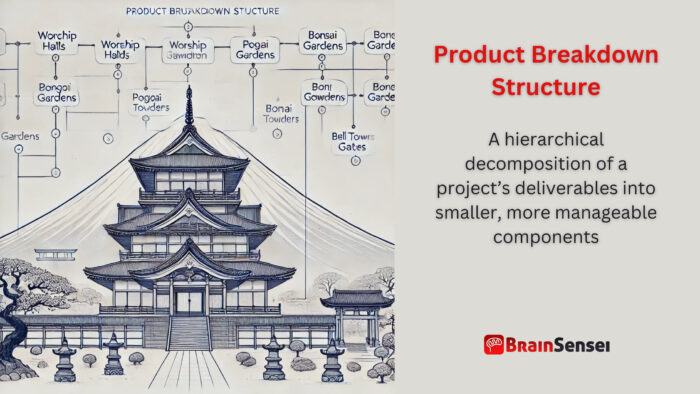
Product Breakdown Structure
What is a Product Breakdown Structure?
A product breakdown structure (PBS) is a hierarchical decomposition of a project’s deliverables into smaller, more manageable components. It focuses on the end product rather than the activities required to produce it, ensuring clarity around project outcomes and deliverables.
Key Takeaways
- Provides a clear visualization of project deliverables
- Enhances communication and clarity among project stakeholders
- Supports accurate resource allocation and task assignment
- Aligns project efforts with desired outcomes
- Reduces the risk of overlooking key deliverables
Understanding the Product Breakdown Structure
How It Works
The PBS breaks down the final product into components, subcomponents, and individual parts. This process helps understand what needs to be delivered and facilitates effective planning, monitoring, and control.
- Identify the final product.
- Decompose into primary components.
- Further breakdown components into subcomponents.
- Document each component with descriptions and specifications.
Notes
- Focuses on deliverables, not tasks
- It should be detailed enough for clarity but not overly complex
- Requires regular updates to reflect changes in project scope
- Should align with the Work Breakdown Structure (WBS)
Related Terms
- Work Breakdown Structure (WBS): A hierarchical breakdown of project tasks and activities.
- Deliverable: A tangible or intangible product resulting from project work.
- Project Scope: The defined work and deliverables required to complete a project.
- Milestone: A significant point or event within a project timeline.
- Project Charter: A document defining the project’s purpose, scope, and objectives.
Examples of Product Breakdown Structure
Manufacturing Industry
A company manufacturing a new type of refrigerator uses PBS to break down the product into components like the cooling system, electrical wiring, outer shell, and insulation materials. The team decompose each element into smaller parts, such as thermostats, compressors, and evaporator coils. For instance, they broke down the cooling system into the compressor, evaporator, condenser, and expansion valve. Each part has distinct roles that contribute to the product’s overall functionality. The PBS helps the project team allocate resources efficiently, track the progress of each component, and ensure quality control throughout the manufacturing process. By clearly defining each deliverable, the team minimizes the risk of missing critical parts and streamlines supplier coordination.
Moreover, PBS supports better collaboration across departments. For instance, the engineering team can use the PBS to verify the technical requirements for each component, while the procurement team uses it to manage supplier contracts for necessary materials. This detailed breakdown helps avoid confusion, mainly when specifications change occurs mid-project. Additionally, the PBS is a reference point during quality inspections, ensuring that each part meets the required standards before assembly.
IT & Software Development
An IT company developing a customer relationship management (CRM) system applies PBS by dividing the product into modules like user interface, database, analytics, and security. The analytics module comprises reporting, dashboards, and predictive analysis components. Each element requires distinct technical expertise and has specific dependencies. For example, the database must be fully operational before the analytics module can generate accurate reports. The PBS ensures the development team understands how each module contributes to the software architecture.
Furthermore, the PBS aids in task prioritization during the development lifecycle. Agile teams use it to define deliverables for each sprint, ensuring that essential components like user authentication and completing data encryption early. The team updates the PBS to reflect the evolving product structure as they add new features. This adaptability makes it an indispensable tool for iterative development processes.
Aerospace Industry
An aerospace company constructing a satellite uses PBS to outline its structure into segments like the propulsion system, communication modules, power supply, and thermal control. The engineers divide the communication module into antennas, receivers, and transmitters. Each component is further detailed into subcomponents such as transponders, filters, and signal processors. The PBS not only aids in manufacturing and assembly but also plays a crucial role in risk management by identifying critical components whose failure could jeopardize the entire mission.
For example, the power supply system’s PBS reveals the intricate dependencies between solar panels, batteries, and power distribution units. The team rigorously tests design specifications to ensure that they meet the requirements. Additionally, PBS helps coordinate work across different teams, such as mechanical engineers focusing on the propulsion system and software developers working on navigation algorithms. When integrated with project management tools, PBS can provide real-time updates on component readiness, minimizing delays and enhancing collaboration.
Additionally, the PBS in these industries fosters improved stakeholder communication by clearly representing the product structure. This clarity helps bridge the gap between technical teams and project sponsors, ensuring that expectations align from project inception to completion.
Use Cases of Product Breakdown Structure
United States (Construction Project)
In a U.S.-based skyscraper project, PBS ensures clarity on deliverables like structural framework, HVAC systems, and interior fittings. The team uses the PBS to assign responsibilities, manage suppliers, and track progress. The PBS also facilitates communication among various contractors involved in the project. For example, when the electrical wiring phase begins, the PBS ensures the wiring team understands which panels and fixtures they need for each floor. Additionally, it helps project managers monitor deliverables against the timeline and budget, reducing the likelihood of cost overruns. The team identifies and resolves potential bottlenecks early through regular PBS reviews, maintaining project momentum.
Moreover, PBS is a vital tool for risk management in the construction industry. For instance, when sourcing materials from different suppliers, PBS helps track the delivery schedule and quality specifications. If a delay occurs in delivering HVAC components, the PBS highlights which subsequent tasks may be affected, enabling the team to adjust the schedule accordingly. This proactive approach minimizes disruptions and ensures timely project completion.
Germany (Automotive Development)
A German car manufacturer uses PBS to develop an electric vehicle. The PBS helps break down the product into the powertrain, battery pack, and infotainment system, ensuring precise component tracking. Each system is further detailed into subcomponents, such as motors, controllers, and lithium-ion cells. This level of granularity helps the engineering team manage interdependencies between systems and allocate resources effectively.
The PBS also supports compliance with industry regulations. For example, safety components like airbags and braking systems undergo stringent testing. Using PBS, the company tracks these components’ development stages and obtains all necessary certifications before production. Additionally, PBS facilitates collaboration with external suppliers by clearly defining outsourced parts’ specifications and delivery expectations.
PBS also plays a key role in quality assurance. It provides a reference framework for evaluating each component’s performance during prototype testing. Engineers can quickly trace the problem to specific cells or control circuits if an issue arises with the battery pack. This traceability accelerates troubleshooting and improves overall product reliability.
South Korea (Telecom Infrastructure)
A telecom company in South Korea uses PBS for a 5G network rollout, categorizing deliverables into hardware, software, and network protocols to streamline installation. The PBS breaks down the hardware into components like base stations, antennas, and fibre optic cables. They divide the software into network management tools, security modules, and user applications.
The PBS enhances project coordination across multiple teams working in different regions. For instance, while the installation team sets up base stations in urban areas, the software team configures network protocols and security features. Regular PBS updates help synchronize these efforts, ensuring hardware components are compatible with the software environment.
Additionally, PBS supports scalability planning. As network demand increases, the PBS helps identify which components require upgrades or additional resources. For example, if certain base stations experience high traffic, the PBS highlights the need for additional antennas or bandwidth allocation. This proactive approach ensures consistent network performance and customer satisfaction.
Best Practices in Product Breakdown Structure
Implementing a Product Breakdown Structure (PBS) requires a strategic and methodical approach to avoid common pitfalls and maximize its effectiveness. Here are some best practices:
Define the Final Product Clearly
Begin with a well-defined understanding of the final product. Ambiguity at this stage can confuse downstream. Engage stakeholders early to align expectations and clarify deliverables.
Collaborate Across Departments
Departments ensure that cross-functional inputs consider all aspects of the product. For instance, the development and support teams should contribute to the PBS in software development.
Use Visual Tools and Software
Utilize tools like Microsoft Visio, Lucidchart, or project management software with PBS features. Visual representations make complex structures more comprehensible for stakeholders.
Regularly Review and Update the PBS
As projects evolve, deliverables might change due to scope adjustments or new requirements. Schedule periodic reviews to update the PBS accordingly.
Maintain a Balance Between Detail and Simplicity
Avoid excessive detail that can overwhelm the team, but provide enough information to eliminate ambiguity. The level of detail should correspond to the project’s complexity.
Align with the Work Breakdown Structure (WBS)
While the PBS focuses on deliverables, the WBS addresses tasks and activities. Ensure both structures are aligned to maintain consistency in project planning.
Train Teams on PBS Principles
Educate project team members on PBS concepts and the importance of deliverable-based planning. This understanding promotes better collaboration and adherence to the structure.
Document Component Details
Maintain documentation for each component, including descriptions, specifications, and dependencies. This documentation aids in quality assurance and future reference.
Ignoring these practices can lead to miscommunication, overlooked deliverables, and project delays. In one construction project, for example, a lack of regular PBS reviews resulted in missing HVAC components, delaying the project’s completion by several weeks. By adhering to these best practices, teams can ensure a more streamlined and efficient project execution.
Common Mistakes and Issues
Implementing a PBS, though beneficial, can present challenges if not approached correctly. Common mistakes include:
Confusing PBS with WBS
One of the most frequent errors is mistaking PBS for WBS. While PBS focuses on deliverables, WBS outlines the tasks required to create those deliverables. This confusion can result in incomplete or poorly defined PBS components.
Insufficient Detail
Providing too little detail can leave team members uncertain about what each component should include. For example, a healthcare IT project suffered delays when the specifications of the PBS components for software modules were unmet, causing rework and increased costs.
Overly Complex Structures
Conversely, overly detailed PBS diagrams can overwhelm teams and impede progress. Striking a balance is essential.
Lack of Stakeholder Involvement
Failing to include key stakeholders during PBS creation may lead to missed deliverables and misaligned expectations.
Neglecting Updates
PBS must be dynamic; failing to update it in response to project changes can render it obsolete, leading to confusion and potential project failures.
Ignoring Dependencies
Overlooking relationships between components can cause delays. This issue occurs especially when the project team fails to schedule dependent tasks.
Learning from these mistakes through regular training and consistent reviews can improve PBS’s effectiveness.
Frequently Asked Questions (FAQs)
How does PBS differ from WBS?
PBS focuses on deliverables, while WBS focuses on activities.
Why is PBS important in project management?
It provides clarity on what the project will deliver, ensuring stakeholder alignment.
Can PBS be applied to service-based projects?
Yes, by defining service deliverables like reports, tools, and documentation.
Who is responsible for creating the PBS?
Typically, project managers collaborate with technical teams.
How detailed should the PBS be?
It should be detailed enough to avoid ambiguity but not so granular as to become unmanageable.
Additional Resources
Preparing for a PMI certification?
- Exam Prep Courses: PMP®, CAPM®, and PMI-ACP®
- Exam Simulators: PMP®, CAPM®, PMI-ACP®, PMI-PBA®, PMI-RMP®, PMI-SP®, PgMP®, and PfMP®
- Professional Development Units (PDUs): 15, 30, and 60 PDU Bundles



